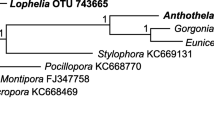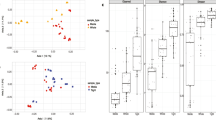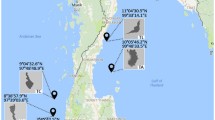Abstract
Corals are sessile eukaryotic hosts which provide a unique surface for microbial colonization. Culture independent studies show that the coral mucus and tissue harbour diverse and abundant prokaryotic communities. However, little is known about the diversity of bacteria associated with the corals of Gulf of Mannar. The present study characterised the bacterial diversity associated with the mucus of the coral Acropora digitifera from the Gulf of Mannar by 16S rRNA gene clone library construction. The bacterial communities of the mucus of A. digitifera were diverse, with representatives within the Alphaproteobacteria, Gammaproteobacteria, Actinobacteria, Firmicutes and several unclassified bacteria. The culture independent bacterial population was totally different from our previous culture dependent study of the mucus and tissue of the same coral. 36% of the bacteria in the clone library of A. digitifera were found to be novel after full length sequencing of the 16S rRNA gene wherein several clones were found to be novel at the Genus and species level. The current study further supports the findings that Actinobacteria amount to a certain proportion among bacterial communities associated with corals.




Similar content being viewed by others
References
Altschul SF, Madden T, Schaffer AA, Zhang J, Anang Z, Miller W, Lipman DJ (1997) Gapped BLAST and PSI-BLST: a new generation of protein database search programs. Nucleic Acids Res 25:3389–3402
Babu TG, Nithyanand P, Babu NKC, Pandian SK (2009) Evaluation of cetyltrimethylammonium bromide as a potential short-term preservative agent for stripped goat skin. World J Microbiol Biotechnol 25:901–907
Bakkiyaraj D, Pandian SK (2010) In vitro and in vivo antibiofilm activity of a coral associated actinomycete against drug resistant Staphylococcus aureus biofilms. Biofouling 26:711–717
Bernan VS, Greenstein M, Carter GT (2004) Mining marine microorganisms as a source of new antimicrobials and antifungals. Curr Med Chem Anti-Infect Agents 3:181–195
Choi JH, Jung HY, Kim HS, Cho HG (2000) PhyloDraw: a phylogenetic tree drawing system. Bioinformatics 16:1056–1058
Cofforth MA (1990) Mucus sheet formation in portid corals: an evaluation of coral mucus as nutrient source on reefs. Mar Biol 105:39–49
de Pascale D, Cusano AM, Autore F, Parrilli E, di Prisco G, Marino G, Tutino ML (2008) The cold-active Lip1 lipase from the Antarctic bacterium Pseudoalteromonas haloplanktis TAC125 is a member of a new bacterial lipolytic enzyme family. Extremophiles 12:311–323
Egan S, Thomas T, Kjellberg S (2008) Unlocking the diversity and biotechnological potential of marine surface associated microbial communities. Curr Opinion Microbiol 11:219–225
Frias-Lopez J, Zerkle AL, Bonheyo GT, Fouke BW (2002) Partitioning of bacterial communities between seawater and healthy, black band diseased and dead coral surfaces. Appl Environ Microbiol 68:2214–2228
Gontang EA, Fenical W, Jensen PR (2007) Phylogenetic diversity of gram-positive bacteria cultured from marine sediments. Appl Environ Microbiol 73:3272–3282
Guppy R, Bythell JC (2006) Environmental effects on bacterial diversity in the surface mucus layer of the reef coral Montastraea faveolata. Mar Ecol Prog Ser 137:133–142
Klaus JS, Janse I, Heikoop JM, Sanford RA, Fouke BW (2007) Coral microbial communities, zooxanthellae and mucus along gradients of seawater depth and coastal pollution. Environ Microbiol 9:1291–1305
Kooperman N, Ben-Dov E, Kramarsky-Winter E, Barak Z, Kushmaro A (2007) Coral mucus-associated bacterial communities from natural and aquarium environments. FEMS Microbiol Lett 276:106–113
Kumaraguru AK (1997), “Project title: Ecology of ornamental fishes of export value in the Gulf of Mannar”, Project report for the period ending 31-1-97, School of energy, environment and natural resources, Madurai Kamaraj University, Madurai, sponsored by Department of ocean development, GOI
Lampert Y, Kelman D, Nitzan Y, Dubinsky Z, Behar A, Hill RT (2008) Phylogenetic diversity of bacteria associated with the mucus of Red sea corals. FEMS Microbiol Ecol 1:1–17
Lane DJ (1991) 16S/23S rRNA sequencing. In: Stackebrandt E, Goodfellow M (eds) Nucleic acid techniques in bacterial systematics. Wiley, New York, pp 115–175
Lee YK, Jung HJ, Lee HK (2006) Marine bacteria associated with the Korean Brown Alga, Undaria pinnatifida. J Microbiol 44:694–698
Li Z, Hu Y, Liu Y, Huang Y, He L, Miao X (2007) 16S rRNA gene clone library-based bacterial phylogenetic diversity associated with three South China Sea sponges. World J Microbiol Biotechnol 23:1265–1272
Li H, Lee BC, Kim TS, Bae KS, Hong J, Choi SH, Bao B, Jung JH (2008) Bioactive cyclic dipeptides from a marine sponge-associated bacterium, Psychrobacter sp. Biomol Ther 16:356–363
Meikle P, Richards GN, Yellowlees D (1988) Structural investigations on the mucus from six species of coral. Mar Biol 99:187–193
Nissimov J, Rosenberg E, Munn CB (2009) Antimicrobial properties of resident coral mucus bacteria of Oculina patagonica. FEMS Microbiol Lett 292:210–215
Nithya C, Pandian SK (2009) Isolation of heterotrophic bacteria from Palk Bay sediments showing heavy metal tolerance and antibiotic production. Microbiol Res 165:578–593
Nithyanand P, Pandian SK (2009) Phylogenetic characterization of culturable bacterial diversity associated with the mucus and tissue of the coral Acropora digitifera from Gulf of Mannar. FEMS Microbiol Ecol 69:384–394
Nithyanand P, Thenmozhi R, Rathna J, Pandian SK (2010) Antibiofilm activity of coral associated bacteria against different clinical M serotypes of Streptococcus pyogenes. Current Microbiol 60:454–460
Perrière G, Gouy M (1996) WWW-query: an on-line retrieval system for biological sequence banks. Biochimie 78:364–369
Radjasa OK, Martens T, Grossart HP, Sabdono A, Simon M, Bachtiar T (2004) Antibacterial property of a coral-associated bacterium Pseudoalteromonas luteoviolacea against shrimp pathogenic Vibrio harveyi (in vitro study). J Coast Develop 7:121–169
Rappe MS, Giovannoni SJ (2003) The uncultured microbial majority. Annu Rev Microbiol 57:369–394
Ritchie KB (2006) Regulation of marine microbes by coral mucus and mucus associated bacteria. Mar Ecol Prog Ser 322:1–14
Ritchie KB, Smith GW (1995) Preferential carbon utilization by surface bacterial communities from water mass, normal, and white-band diseased Acropora cervicornis. Mol Marine Biol Biotechnol 4:345–352
Rohwer F, Breitbart M, Jara MJ, Azam F, Knowlton N (2001) Diversity of the bacteria associated with Caribbean coral Montastraea franksi. Coral Reefs 20:85–91
Rohwer F, Seguritan V, Azam F, Knowlton N (2002) Diversity and distribution of coral-associated bacteria. Mar Ecol Prog Ser 243:1–10
Rosenberg E, Koren O, Reshef L, Efrony R, Rosenberg LZ (2007) The role of microorganisms in coral health, disease and evolution. Nat Rev Microbiol 355:349–360
Shnit-Orland M, Kushmaro A (2009) Coral mucus associated bacteria: a possible first line of defense. FEMS Microbiol Ecol 67:371–380
Srinivas TN, Nageswara Rao SS, Vishnu Vardhan Reddy P, Pratibha MS, Sailaja B, Kavya B, Hara Kishore K, Begum Z, Singh SM, Shivaji S (2009) Bacterial diversity and bioprospecting for cold-active lipases, amylases and proteases, from culturable bacteria of kongsfjorden and Ny-alesund, Svalbard, Arctic. Curr Microbiol 59:537–547
Stackebrandt E, Goebel BM (1994) Taxanomic note: a place for DNA-DNA reassociation and 16S rRNA sequence analysis in the present species definition in bacteriology. Int J Syst Bacteriol 44:846–849
Sunagawa S, DeSantis TZ, Piceno YM, Brodie EL, DeSalvo MK, Voolstra CR, Weil E, Andersen GL, Medina M (2009) Bacterial diversity and white plague disease-associated community changes in the Caribbean coral Montastraea faveolata. ISME J 3:512–521
Thenmozhi R, Nithyanand P, Rathna J, Pandian SK (2009) Antibiofilm activity of coral associated bacteria against different clinical M serotypes of Streptococcus pyogenes. FEMS Immunol Med Microbiol 57:284–294
Thompson J, Gibson DTJ, Plewniak F, Jeanmougin F, Higgins DG (1997) The ClustalX windows interface: flexible strategies for multiple sequence alignment aided by quality analysis tools. Nucleic Acids Res 24:4876–4882
Wild C, Huettel M, Klueter A, Kremb SG, Rasheed MYM, Jørgensen BB (2004) Coral mucus functions as an energy carrier and particle trap in the reef ecosystem. Nature 428:66–70
Yu Y, Breitbart M, McNairnie P, Rohwer F (2006) FastGroupII: a web-based bioinformatics platform for analyses of large 16S rRNA gene libraries. BMC Bioinfo 7:57
Acknowledgments
This work was supported by the Department of Biotechnology, Government of India; Grant no. BT/PR3987/AAQ/03/198/2003. The authors gratefully acknowledge the computational and bioinformatics facility provided by the Alagappa University Bioinformatics Infrastructure Facility (funded by the Department of Biotechnology, Government of India; Grant no. BT/BI/25/001/2006). The financial support provided to P.N. by the Department of Biotechnology, Government of India (Grant no. BT/PR3987/AAQ/03/198/2003) in the form of a Research Fellowship is gratefully acknowledged.
Author information
Authors and Affiliations
Corresponding author
Electronic supplementary material
Below is the link to the electronic supplementary material.
Rights and permissions
About this article
Cite this article
Nithyanand, P., Indhumathi, T., Ravi, A.V. et al. Culture independent characterization of bacteria associated with the mucus of the coral Acropora digitifera from the Gulf of Mannar. World J Microbiol Biotechnol 27, 1399–1406 (2011). https://doi.org/10.1007/s11274-010-0591-4
Received:
Accepted:
Published:
Issue Date:
DOI: https://doi.org/10.1007/s11274-010-0591-4




